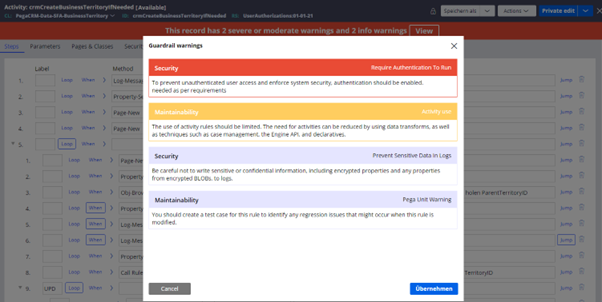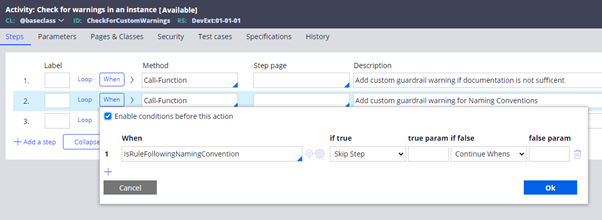In today's rapidly evolving digital landscape, businesses strive to deliver applications that not only meet the needs of their customers but also offer seamless experiences and adaptability for the future. However, achieving these goals can be a complex endeavor, requiring a comprehensive framework that ensures consistent, reliable, and efficient application development. This is where Pega guardrails come into play, providing a robust set of design principles and best practices to guide developers throughout their Pega platform journey.
Pega guardrails are like a compass, pointing developers in the right direction as they navigate the intricate landscape of application design and development. They offer a blueprint that promotes adherence to industry best practices, accelerates development cycles, and ultimately leads to the creation of high-quality, scalable applications.
In this blog post, we will explore the remarkable benefits of leveraging Pega guardrails in application development. From ensuring consistency and standardization to early issue detection, improved application quality, and enhanced maintainability, we will delve into the core advantages that guardrails bring to the table. We will uncover how these guardrails empower development teams to optimize performance, achieve compliance with security and regulatory standards, and future-proof their applications against evolving technology landscapes.
Whether you are a Pega developer, architect, or an organizational leader seeking to streamline and elevate your application development processes, Pega guardrails will help you in various topics.
.jpg?width=400&height=225&name=only-ppt_high-five%20(3).jpg)
Attention high-flyers: join the USU Pega team!

Main benefits of using Pega guardrails
Improved Quality and Reliability
By enforcing best practices and design principles, Pega guardrails contribute to improved application quality. They guide developers towards building scalable, maintainable, and performant applications. Guardrails help prevent common mistakes and anti-patterns, resulting in cleaner design, fewer bugs, and a higher overall quality of the application.

The picture showcases some of the guardrails developers can observe while actively engaged in the development process. It enables users to promptly address any identified guardrails, resulting in the creation of statements that adheres to higher quality standards.
Consistency and Standardization
Pega guardrails establish a set of rules and best practices that developers must follow. This ensures consistency in application design and development across the organization. By adhering to guardrails, teams can create applications that have a consistent look and feel, follow standardized coding practices, and maintain a cohesive user experience.
There is also the possibility to add custom guardrails, for example a organization can enforce internal coding standards and guidelines. This ensures consistency and quality across applications by providing specific rules for variable naming, design structure, error handling, and logging practices. By adhering to this custom guardrail, developers maintain a consistent coding style, improve maintainability, and produce higher-quality applications.

Time and Cost Savings
Pega guardrails provide real-time feedback and warnings to developers while they are designing and building applications. This helps identify potential issues and errors early in the development process, reducing the chances of introducing defects. By catching problems early, guardrails save time and effort that would otherwise be spent on debugging and fixing issues during later stages of development.
Compliance with Security and Regulatory Standards
Guardrails in Pega incorporate security and compliance best practices, ensuring that applications are built with security in mind. They guide developers in implementing secure authentication mechanisms, data encryption, access controls, and other security measures. By adhering to these guardrails, organizations can meet regulatory requirements, protect sensitive data, and mitigate security risks.

The Guardrail overview provides a convenient way to observe a comprehensive summary of an application, enabling quick assessment of guideline adherence. By utilizing this overview, one can easily verify whether all guidelines have been duly addressed.
Rule Governance and Reusability
Guardrails promote proper rule governance and reusability. They guide you in organizing rules into logical structures such as rulesets and application layers. This helps establish a well-structured application architecture, making it easier to manage dependencies, track changes, and promote rule reuse. Following guardrails for rule governance ensures a more organized and efficient development process.

Want to get the most out of your Pega software? USU has the certified experts for your Pega projects!!
In conjunction with the extensive range of existing Pega guardrails, you have the capability to introduce new ones that are specifically tailored to your organization or use case. This exceptional flexibility enables you to achieve an even higher level of adherence to global standards. By incorporating custom guardrails, you can align your applications more precisely with the unique requirements and guidelines of your organization, ensuring optimal compliance and elevating the overall quality of your solutions.
Upgrade Compatibility
Pega guardrails promote future-proofing of applications by encouraging the use of best practices and avoiding deprecated features or functionalities. Following guardrails ensures that applications are compatible with future upgrades and platform changes. By adhering to recommended practices, organizations can minimize the effort required during system upgrades and take advantage of new platform features without extensive rework.
Take away
Overall, Pega guardrails provide a framework for disciplined and efficient application development, resulting in higher-quality applications that are easier to maintain, perform well, and comply with security and regulatory standards. It is a built-in functionality Pega provides out of the box and a great tool for everyone using it.